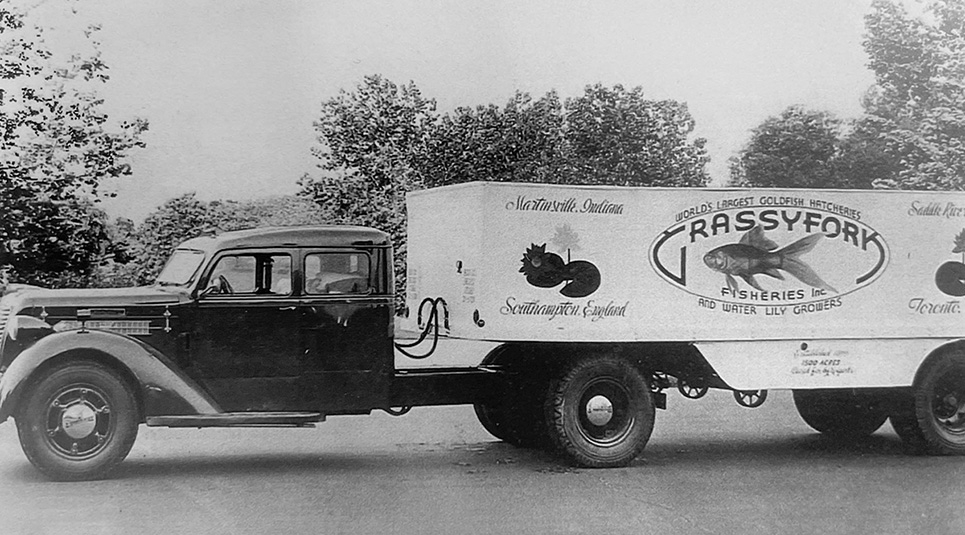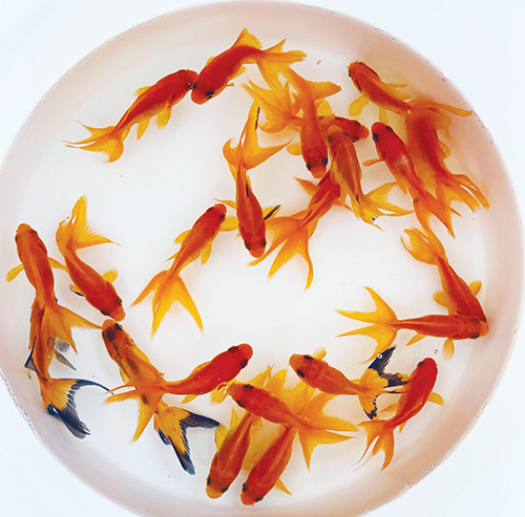
Being a fourth-generation fish farmer, I grew up on my family’s ornamental goldfish and koi farm in rural Missouri. My love of fish was instilled in me as a young girl, and the process of shipping live fish has always fascinated me. My dual understanding of the importance of overall fish health and safely packaging ornamental fish for transit has evolved significantly over time.
“You Can Ship Live Fish?”
If you keep or sell fish, you likely get them from your local pet shop or garden center, a big box store, a local fish farm … or perhaps you have them imported from overseas? Time and time again, we get the same response from folks who are unfamiliar with ornamental fish farming. “You can ship live fish?”
I am always perplexed by this question. How do people think pet stores and garden centers get their fish? Many people do not realize that while a lot of fish are delivered using live haul trucks, most ornamental fish are transported in cardboard boxes via an overnight delivery service.
Today, there are lots of ways for fish enthusiasts to find and source fish. But what is the best way to safely transport ornamental fish, and how do your fish really travel? While this might initially seem simple, the process is complex, with a lot of moving pieces.
Travel Agents for Fish

For fish farmers, the process starts with spawning and producing high-quality, healthy fish. Farmers take great care in feeding and observing the fish to ensure health and quality. On most fish farms, fish spend most of their time on the farm growing in earthen dirt ponds. When the fish are ready, they are transported from production ponds into shipping facilities. They are then processed by variety, size, and overall quality. This is done by using graders, hand sorting and, in some cases, examining individual fish.
Handling fish can be stressful on them and make them more susceptible to disease issues. It is important to limit any unnecessary handling and take precautionary measures to make the process as low-stress as possible. Shipping team members are diligent in their efforts to keep fish healthy and sellable. Once the koi and goldfish have been separated by size and variety, they are ready to be sold.
Our farm’s marketing team jokingly describes our job simply as travel agents for fish. We have one job — we must do our best to choose the fastest, most direct way to get fish from our farm to our customer.
With two locations and a well-stocked inventory at both farms, how does our marketing team choose how to ship fish to you? Thanks to advancements in our in-house technology, we evaluate weather conditions to the customer’s destination and the proximity to our farms. With that information, our team will pick the most efficient and affordable way to pack your order and ship it to you. Once an order has been completed by our marketing team, it falls back on our shipping departments to safely pack orders. No matter where you source your fish, they have most likely traveled in a box and plastic bag via FedEx, UPS or air freight.
Littoral Logistics
Fish trade and movement in the United States has a long history. While some goods were relatively easy to move across the county, live fish have always had transportation limitations due to the water and oxygen needed to keep them alive. In the early days of fish transport, live haul delivery trucks were most common. This came with its own set of issues because of the limited road and highway systems at that time.
Surprisingly, fish were also commonly transported by railroad in the 1870s through the late 1940s. Fish traveled inside metal cans filled with water and ice blocks placed on top of the can. As the ice blocks melted, the fresh water would percolate down into the container and add oxygen. There were even a few modified railway cars that were made into fish cars to safely hold and move fish across the country.
In the late 1940s, travel by railroad became less reliable, and the use of metal cans limited fish from being shipped via new methods like air freight. With the more widespread use of plastic, new shipping methods were developed. While there were several iterations of shipping fish in boxes, the basics of this method include fish being added with water in an oxygen-inflated plastic bag. That bag is then sealed and shipped inside a corrugated cardboard box. It took many years of testing this method of shipping live fish in a box to determine it was safe enough for both the fish and all the other packages being delivered as well.
Over the years, updates to this shipping method have included using insulated liners to regulate water temperature during transport. The use of gel ice packs or heat packs along with chemicals to help regulate ammonia or keep fish calm during transport are also sometimes used.

Shipping Live Fish in a Cardboard Box
The advancement of technology in shipping fish has allowed individuals today a wide range of options to obtain their fish. You can go to your local pet store, visit a local water garden shop, get your fish direct from a breeder or import fish from abroad. For some in rural areas without access to a local pet shop, finding a reliable source for fish is becoming harder and harder. Due to this, ordering fish online and having them shipped directly to you is becoming a more popular option.
In fact, shipping fish in a cardboard box is now the industry standard of shipping all types of live fish throughout the world, as it has proven to be a much lighter and less expensive shipping method. It has opened up the possibility of shipping live fish via air freight and numerous other markets that previously weren’t available to the aquaculture industry.
Even with the difficulties and uncertainties of flight availability over the past couple of years, shipping fish via air freight continues today to be one of the most common avenues for shipping live fish.
The U.S. Postal Service was widely used for a brief period, but it has proven to be too slow and unreliable to be trusted with live fish. Delivery services like UPS, FedEx and DHL are the most popular overnight delivery options in North America.
Buyers Beware!
When bringing in new fish, always do your research! Check the reviews and ask the supplier questions. Did the supplier take extra care in limiting the overall stress of the koi or goldfish? What steps does their team take to provide a healthy product?
While the weight of shipping high-quality fish falls on the shoulders of your fish supplier, it is important that you are prepared to receive an order.
Have you prepared your system to receive fish? It is best to have your system set up and cycling for at least a week or two before adding any live fish. If you already have an established system with fish, make sure to quarantine any new fish before adding them.
Are your weather conditions acceptable to receive fish? Whether you are going to pick them up locally or you are ordering online and having them delivered, make sure you are doing so in cooler conditions. Adding new fish to your system in cooler weather is less stressful on the fish during transport and in the acclimation process upon arrival.
How can you minimize the stress level of the fish you’re purchasing? Using local fish source options when possible, like local pet stores or water gardens, is a great option. For wholesale ordering, purchasing direct from a U.S. breeder or fish farm will decrease handling and stress for the fish.
Delivery Instructions
If you are purchasing from a supplier that ships their product, make sure your fish are going to be shipped for overnight delivery. Fish that are packaged for multiple days are most susceptible to stress-related health issues.
If you are purchasing fish locally, do so in the coolest part of the day. If you need fish in the warmer months, pick the coolest day of the week to receive your order. If you are shipping in an order, think about having it shipped to your local UPS or FedEx center. Some of these centers offer pick-up options as early as 9:00 a.m.
Make sure to track your shipment so you know when it will arrive. The shipper should include acclimation instructions, but it is always a good idea to do your own research on how to acclimate the specific type of fish you are receiving before they arrive.
Whether you purchase fish direct from a fish farm, a local pet store or garden center, it takes great care and teamwork for your fish to safely travel to you.



